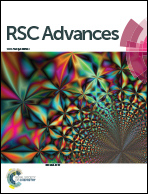Luminescence and structural analysis of Ce3+ and Er3+ doped and Ce3+–Er3+ codoped Ca3Sc2Si3O12 garnets: influence of the doping concentration in the energy transfer processes
Abstract
We present research on Ca3Sc2Si3O12 garnets doped with Ce3+ and Er3+ ions that were synthesized by the freeze-drying precursor method. The structural characterization was performed by X-ray diffraction (XRD) and X-ray photoelectron spectroscopy (XPS). Scanning electron microscopy (SEM) images of the calcined material were studied. Nanocrystals of Ca3Sc2Si3O12 were obtained by calcining the precursor at 1200 °C for 4 h with a mean size of about 100 nm. The luminescence features of Ce3+ and Er3+ doped samples indicated that these ions are effectively incorporated into the crystalline phase. In addition, codoping with Ce3+–Er3+ ions results in energy transfer processes from Ce3+ to Er3+ ions which led to the enhancement of near-infrared luminescence at 1.5 μm. The efficiency of this non-radiative energy transfer process has been studied by means of excited state dynamics as a function of the doping concentration. From these results we have found that near-infrared Er3+ luminescence efficiency under VIS Ce3+ excitation is at maximal for 1Ce3+–1Er3+ codoped Ca3Sc2Si3O12 garnets (in mol%). Luminescence quenching at higher Er3+ ion concentrations is observed.


 Please wait while we load your content...
Please wait while we load your content...